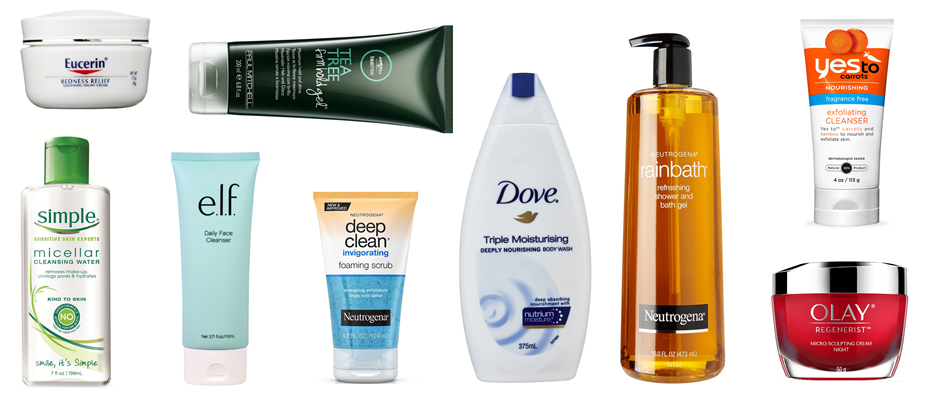
Formaldehyde Releasers
the problem
Formaldehyde is an effective preservative that also happens to be a known human carcinogen. Cosmetics companies include formaldehyde releasing chemicals in formulas to eliminate bacteria and contamination and hence extend the shelf life of their products. They can be found in skincare, hair care and even baby products. According to the World Health Organisation, when formaldehyde is inhaled, it is considered a carcinogen. Topical application classifies it a potent skin sensitiser and allergen.
Pure formaldehyde is not included in skincare. Instead, cosmetic companies use chemicals that when added to water, decompose very slowly over time to form molecules of formaldehyde. This starts to happen immediately upon manufacture and silently continues over the course of the product’s lifetime.
Below are some commonly used skincare products that include formaldehyde releasing preservatives.

Many tests and studies from the US and Europe have been conducted over the years that have shown a high percentage (20%-50%) of cosmetic products containing formaldehyde releasers. More recently, a 2015 study determined that longer storage and higher temperature exposure increases both the amount of formaldehyde released and the associated health concerns.
These tests highlight that together with the other forms of exposure, incidental contact is alarmingly frequent. Often we are exposed to formaldehyde without even realising it. Some sources include:
- Combustion processes such as smoking, heating, cooking and even candle or incense burning;
- Resin soaked wooden products such as particleboard, plywood and medium-density fibreboard;
- Foam insulating materials;
- Textiles, paints, wallpapers, glues, adhesives, varnishes and lacquers;
- Household cleaning products;
- Cosmetics such as liquid soaps, shampoos, conditioners, hair gels, skincare, nail varnishes and nail hardeners;
- Electronic equipment including computers and photocopiers;
They are also commonly found in makeup and included in the examples those shown below:

the effect
Without going into the science too deeply, topical exposure of cosmetic products that emit formaldehyde into the skin results in a compromised DNA repair efficiency. This can give rise to mutations, which in turn when combined with our increasing levels of UV exposure, raises the risk factor for cancer formation.
the chemicals
Manufacturers won’t label their skincare products with the word formaldehyde so chemicals classified as formaldehyde releasers can be difficult to identify. Known formaldehyde releasers include the following with links from the EWG database listing products that contain them.
- DMDM hydantoin
- Imidazolidinyl urea
- Diazolidinyl urea
- Quaternium-15
- Bronopol (2-bromo-2-nitropropane-1,3-diol)
- 5-Bromo-5-nitro-1,3-dioxane
- Polyoxymethylene urea
- Sodium hydroxymethylglycinate
- Glyoxal
the regulations
Japan and Sweden have completely banned the use of such chemicals in cosmetics. In the European Union, personal care products must be clearly labelled and manufacturers must adhere to strict restrictions when including formaldehyde releasers in their formulations. The concentration restrictions that apply in Canada reflect the same limits as those implemented in Australia.

The Australian Department of Health and Ageing regulates the chemicals used in cosmetics. Formaldehyde is restricted by virtue of specified limits:
- 0.1% of free formaldehyde in oral hygiene preparations
- 0.005% or more of free formaldehyde in aerosol sprays for cosmetic use
- 5% or more of free formaldehyde in nail hardeners
- in all other cosmetic preparations containing 0.05% or more of free formaldehyde except in preparations containing 0.2% or less of free formaldehyde when labelled with the warning statement “CONTAINS FORMALDEHYDE”
Most cosmetics are limited to no more than 0.05% unless clearly labelled. Aside from nail hardeners, the maximum permitted concentration in all cosmetics is 0.2% or less of free formaldehyde.
the conclusion
Perhaps at the specified low concentrations which formaldehyde releasers are included in our skincare products, the experts may deem their effects safe. Those with sensitivities would probably disagree, for as a minimum, these preservatives are known allergens and potent sensitizers. However, combine this with all the other sources we are exposed to (consciously or not), it adds up to consistent long term exposure.
Just because a regulatory body claims a chemical is safe at a certain concentration, doesn’t make it right to include it. A tiny bit of a cancer causing substance won’t hurt?? There is something fundamentally wrong with that justification. This is kind of disturbing when you consider that there are so other safer preservation options available. As consumers, we have a responsibility to send the appropriate message companies and manufacturers in the only way that they will listen… As I always say, if in doubt, leave it out or in this case, don’t buy it.
Be selective and be aware of what you put on your skin.
the references
Exposing the Cosmetics Cover-up: Is cancer-causing formaldehyde in your cosmetics? Johanna Congleton, EWG Senior Scientist
Formaldehyde-releasers in cosmetics in the USA and in Europe de Groot AC, Veenstra M
Formaldehyde And Formaldehyde-Releasing Preservatives Campaign for Safe Cosmetics
ACCC research survey of Formaldehyde in Cosmetics Australian Competition And Consumer Commission
Formaldehyde Debra A. Kaden, Corinne Mandin, Gunnar D. Nielsen, and Peder Wolkoff (NCBI)
the disclaimer
Please read in context with my disclaimer.



